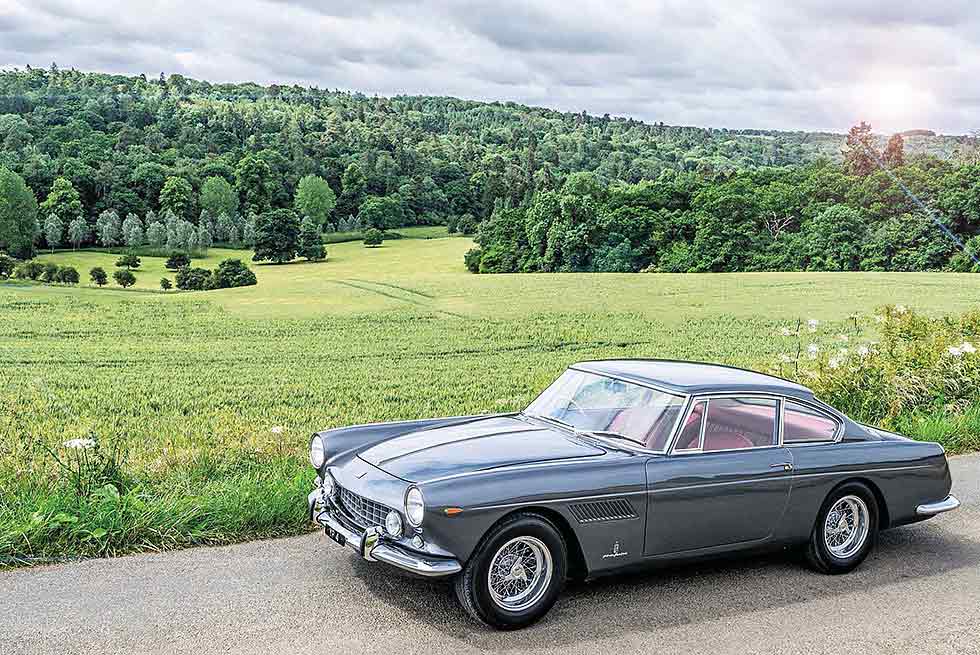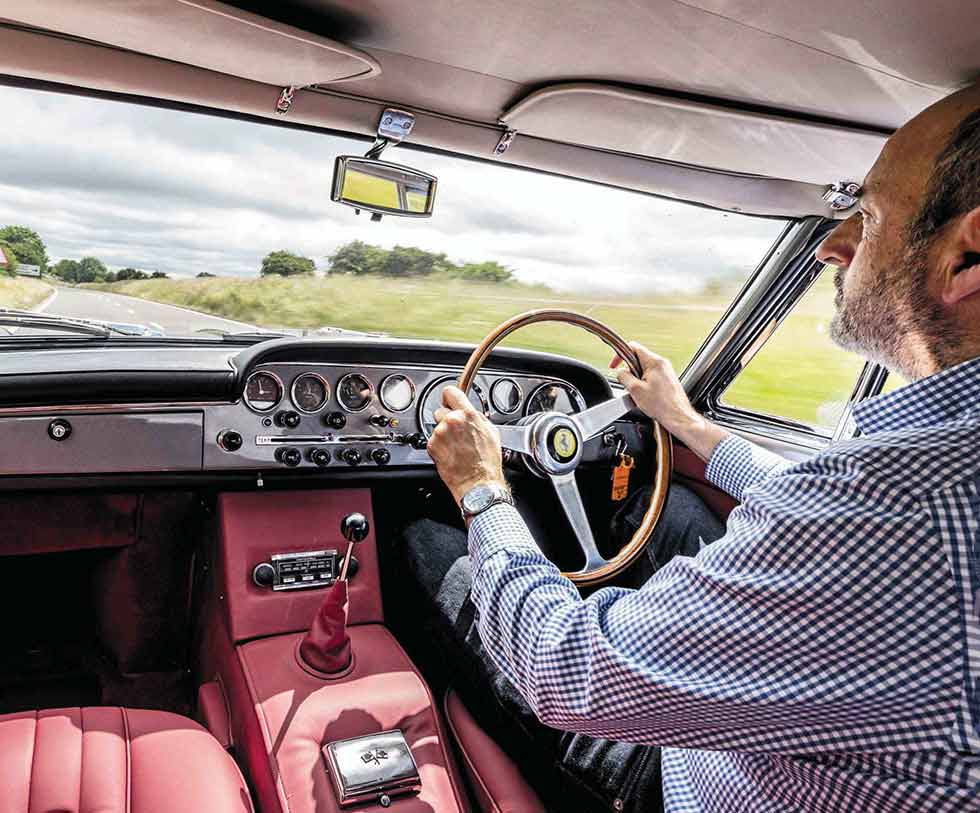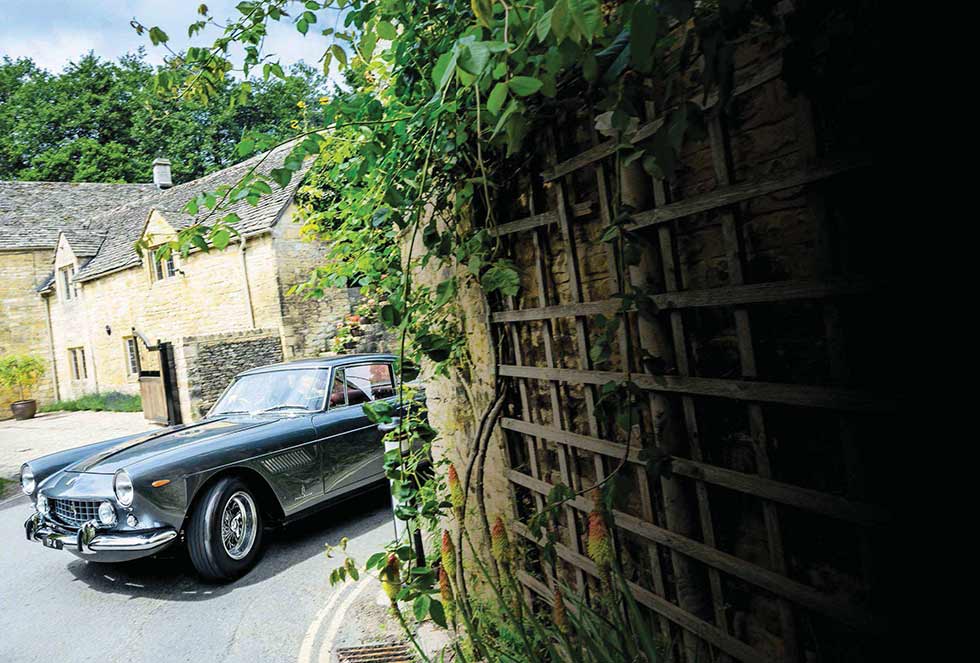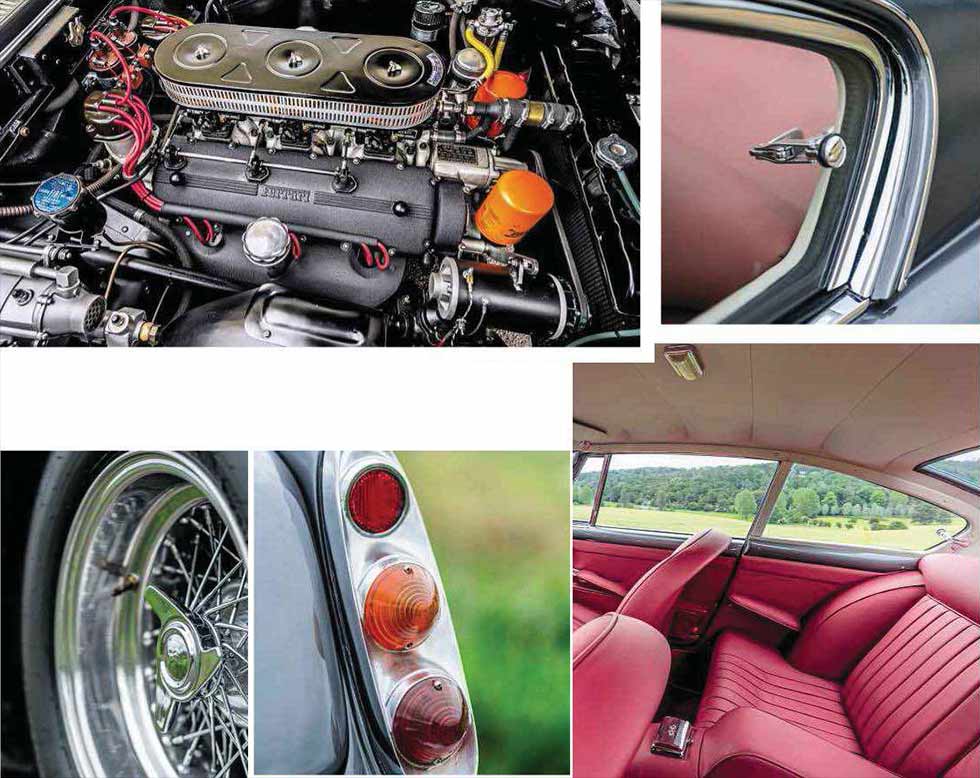
Drive: 1960 Ferrari 250 GTE 2+2. An underrated classic Enzo Ferrari had one as his personal car; Andrew Frankel can now understand why. It was what Enzo himself drove. It was also the best-selling Ferrari of the early ’60s. We take a 250 GTE for a drive in the English countryside. Words Andrew Frankel. Photography Tim Andrew.
COUNTRY CLASSIC 250 GTE 2+2 Time to reappraise an underrated classic
If you were to compile a shortlist of the most important Ferrari road cars, most of its members would not be hard to choose. There’d be the 275 GTB, the 365 GTB/4 Daytona, the Dino 246 GT, the F40 and so on and on, up to the LaFerrari. But how many of you would include this one, the car known variously as the 250 GT 2+2, the 250 GTE and 250 GT/E? Not many, I’m guessing.

But you should. For this was the car that was not only Ferrari’s first successful volume production car, it transformed the business from cottage industry to major manufacturer and, in the process, began a brand new model-line for Ferrari that endures to this day. By the time production ceased in 1963, more than 950 examples had been sold, a hitherto unprecedented number for any Maranello product. Not bad for a car that at one time was thought fit for nothing more than to be butchered to make fake 250 GTOs and SWBs. So next time you see a GTC4 Lusso, an FF, a 612, a 456 or any other four-seat Ferrari, just remember it all started back in 1960 with the car you see here.
‘Almost as soon as we’re off the premises, the GTE starts surprising’
Ok, there will now be those among you ready to point out those Ferraris bodied in the 1950s by such coachbuilders as Vignale and Ghia that were also, in theory at least, capable of carrying more than the regulation two occupants. But these were ultra-low-volume cars and never part of the mainstream Ferrari model line-up. It was the 250 GTE that was Ferrari’s first production family car.

If it seems strange that the GTE didn’t come sooner, given that the likes of Aston Martin had a 2+2 in production by 1953 and that Maserati had found its business transformed in 1957 by the introduction of the 2+2 3500 GT, you need remember only that Ferrari was rarely, if ever, first out of the blocks with such innovations. But the success of the Maserati and, latterly, the Aston Martin DB4, meant that this was a market altogether too lucrative to ignore.
Its design, however, suggests that Ferrari was still not certain it would be a success. For most engineers charged with adapting a chassis to accommodate four people, job one would likely be an extension to the wheelbase. Instead, Enzo Ferrari chose to retain the same 2600mm wheelbase as the standard two-seat 250 GT and change almost everything else.

So the engine was pushed forward by 200mm, the track pumped out at both front and rear, and Pininfarina was commissioned to design a body that was not just longer, but wider and higher, too. With a repositioned fuel tank, the result was a car with the ability to seat four, not occasionally or merely in an emergency but as an everyday proposition for a family with two children. They didn’t even have to be that small. And it came with a boot more than big enough to swallow the holiday luggage of a family keen on careful packing.
Also, Enzo made no attempt to adapt the engineering to suit what was, in effect, a brand new role for a Ferrari road car. In the nose of the spaceframe chassis sat the already-old, single- camshaft-per-bank Colombo V12, still bearing the 58.8mm stroke that had first been introduced in 1948 (and which would continue until 1967).
It had the same 2953cc capacity as the Testa Rossas, SWBs and GTOs, but came with a rather conservative 8.5:1 compression ratio compared with the 9.8:1 used by the sports-acers, and was fed by three 36mm twin-choke Weber DCF carburettors. Claimed outputs range from 235 to 240bhp at 7000rpm. It ran through a four- speed gearbox fitted with a Laycock de Normanville overdrive on top gear.

The chassis was Ferrari convention itself: a coil-sprung double-wishbone arrangement at the front was matched by a leaf-sprung live rear axle at the rear, with disc brakes at all four corners. You could use exactly the same description to describe the chassis of the 175mph 250 GTO.
For Ferrari’s most street-oriented product to date, Enzo chose a somewhat unorthodox venue for his new car to make its world debut: it turned up unannounced at the 1960 running of Le Mans, not as a competitor but a course car. It seems that Ferrari was keen to maintain the racing association and it clearly brought good luck, sparking a run of six successive wins for the Scuderia in the French classic.
Its more formal debut came later that year at the Paris Salon, the first right-hand-drive car being shown at the London Motor Show at Earls Court, wearing dark blue paintwork with a pale blue interior. And while the colours have changed, the car has not. For the car seen here in Grigio Nurburgring paint is the Earls Court car, chassis 2185, owned for the last 30 years or so by renowned Ferrari restorer Bob Houghton.

Bob uses it regularly, so much so that he’s had a special leather-trimmed platform made, which slots in over the rear seats to provide the perfect perch for Jack, his black Labrador. Bob and Jack are in good company: Enzo Ferrari had a GTE of his own and his son Piero has been quoted as saying: ‘He loved the 2+2… this was his personal car. My father was normally driving himself, but he always had a driver with him, and a little dog. So, for him, a two-seat car wasn’t enough.’ The primary difference, then, is that there is nothing ‘little’ about Jack at all.
Bob’s GTE has just emerged from its own restoration and looks suitably magnificent. It may not be one of Pininfarina’s greatest beauties, but the way such interior space has been packaged within such a svelte shape is admirable. To me, only its rather upright nose is a little too formal, but this was a Ferrari for business folk, so perhaps it is to be expected.
There are no such qualms about the interior, for it is nothing less than exquisite. This is a world populated by acres of the finest leather, chrome-rimmed Veglia dials with their spidery numerals set on grey backgrounds, and that stunning alloy-spoked, wood-rimmed Nardi steering wheel. There are chunky push-buttons for ancillary operation, sliders for the ventilation (air-conditioning was not even an option at this time) and, on the right, a simple key slot that, in traditional Ferrari fashion, you twist and push to fire the motor.
The starter churns only briefly before the V12 music begins. To me, this is the song, the one I would play to anyone asking me to define what I love most about cars by sound alone. I’ve heard it in so many places throughout my life and its infinitely complex, multi-layered harmonies never fail to stir my soul.
That said, I have my expectations of this car under quite close control. This is a big car and its 1400kg heft represents a lot of mass by Ferrari standards. It has agricultural rear suspension, soft springs and unassisted worm- and-roller steering. So I’m expecting something heavy, not that quick and, because the motor has been pushed all that way forward, fairly cumbersome, too.

Bob has earmarked some roads for us, and almost as soon as we’re off the premises the GTE starts surprising. The steering is not heavy at all, and nor has its lightness been achieved by that old and crude trick of gearing it so low you have to twirl the wheel like a maniac just to negotiate a roundabout. Instead it operates through just 3.5 turns and with a commendably tight lock – one advantage of the decision not to extend its wheelbase.
And I’m just loving the gearbox. This may be the name-drop to end them all, but the only previous four-speed Ferrari ‘box I’ve driven was in Stirling Moss’s TT-winning alloy-bodied 250 SWB and this one feels equally indestructible and precise. It’s not an especially quick shift, but its meaty feel and absolute absence of any lost motion is simply outstanding.
For now, the engine is content to woofle along, revs low, warming the oil in its sump until the needle on the gauge lifts off its stop. It is so smooth and exquisitely balanced it will pull without complaint from below idling revs in any gear. As you might expect from a medium-sized engine with a dozen cylinders, maximum torque is modest – just 181lb ft developed way up at 5000rpm, but the curve is gentle and suits the car’s grand touring aspirations to perfection. When you consider that this engine was also a multiple Le Mans-winner in the 1950s and ‘1960s, mounted in purpose-built prototypes, you get some idea of its incredible versatility.
The road opens out. Of course I could just make use of the motor’s flexibility and merely flex the toes of my right foot. But I’m done with cruising and want to drive this car like I’m hoping all Ferraris demand to be driven. So down goes the heavy clutch, across and back comes that black-topped, steel shaft. I then reapply the power hard.
The GTE does not leap down the road, but nor does it amble. The exhaust note hardens as a rising crescendo of thrust propels you forward with ever-increasing urgency, the engine sounding happier with every additional 1000rpm. These motors are near-bulletproof and have been buzzed way past 8000rpm with no adverse effect, but Bob’s is new so today we’re not even going to the 7000rpm at which peak power is produced. Even using peak torque as a change-up point, you get to experience the GTE in full flight, and it is an unexpectedly impressive and majestic thing. Even by modern standards the car feels rapid, so strong in fact that I later ask Bob whether the engine has been breathed upon at all. He gives me an old-fashioned look and says it’s standard from end to end.
Which I am sure it is, but, as with the rest of the car, it is clearly in outstanding health. Everything about the GTE is better than I’d imagined. It’s quicker yet quieter, more nimble yet comfortable, so much so that I begin to wonder whether this is not, in fact, the most under-rated Ferrari of them all.
Soon I’ve almost forgotten its extra weight, seats and length. It’s flowing gently but accurately from apex to apex, sitting securely on its Avon-clad Borranis (Pirelli Cinturatos would have been standard when new), its well- cushioned ride belying the primitive nature of its rear suspension. I’m told that GTEs suffer quite pronounced understeer if pushed harder than they care to go, but this seems neither the day nor the car for such behaviour. Grip levels are more than adequate when driving as fast as I want to make the GTE go, and I delight instead just in feeling the car working beneath me.
But I don’t have long enough and, yes, you could say as much about any drive in almost any Ferrari. But I mean it more literally here: by the time I have to return the GTE to Bob, I know I’ve still not seen this car at its best. For a few hours marauding around the Cotswolds is a lovely way of passing the time, but the GTE was born for far greater things. A thousand high-speed miles knocked off in a couple of days with the kids snoozing in the back. I know you can’t do it any more, but I’d bet plenty that the V12 would allow the car to cruise all day long at 120mph in overdrive top in effortless comfort.
Still, I’m delighted just to have made its acquaintance, for the Ferrari 250 GTE was not what I expected at all. No, it was neither the fastest Ferrari I’ve driven nor anywhere near the most exciting. It’s not the most spacious or the most beautiful, either. But the most surprising relative to my expectations” That distinction it claims for itself, and at a canter.
‘The V12 will pull without complaint from below idling revs in any gear’
Specification 1960 Ferrari 250 GTE 2+2
ENGINE V12, 2953cc
MAX POWER 240bhp @ 7000rpm
MAX TORQUE 181lb ft @ 5000rpm
TRANSMISSION Four-speed manual, rear-wheel drive
SUSPENSION Front: double wishbones, coil springs, telescopic dampers, anti-roll bar. Rear: live axle, trailing arms, semi-elliptic leaf springs, lever-arm dampers
STEERING Worm-and-roller, unassisted
BRAKES Solid discs front and rear
WHEELS 6 x 15in wire-spoke
TYRES 185 VR15
WEIGHT 1406kg
POWER TO WEIGHT 173bhp/ton
0-60MPH c8.0sec
TOP SPEED c140mph
{module Ferrari 250}
‘The starter motor churns only briefly before the V12 music begins’
‘I’d bet plenty that it would cruise all day at 120mph in effortless comfort’






